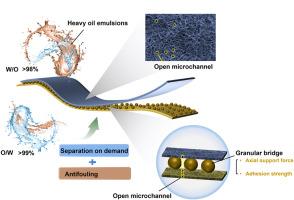具有木质素纳米颗粒桥的稳定 Janus 微/纳米纸用于高效油水乳液分离
IF 10
1区 环境科学与生态学
Q1 ENGINEERING, ENVIRONMENTAL
引用次数: 0
摘要
石油泄漏问题是一个全球性的环境挑战,而Janus膜作为一种极具潜力的解决方案,目前引起了人们的广泛关注。然而,分离通量仍然受到层结构桥接稳定性和微孔孔隙率的限制。本文采用球形结构的多尺度纤维素和木质素纳米颗粒(LNPs),通过颗粒桥策略制备了具有微通道稳定性的光诱导防污Janus微纳米纸,用于分离油水乳液。通过添加多尺度纤维素和LNPs,提高了疏水层的孔隙率,提高了其防污性能。通过引入光诱导分子开关,实现了亲水层的防污性能。在界面相互作用下,在自推进下形成了独特的“亲水-两亲-疏水”纵向流体定向输运结构。此外,考虑到球形LNPs在纤维素中的有序分布,将稳定的颗粒桥结构和合适的开放孔径巧妙地结合在一起。在油水分离领域,对表面活性剂稳定乳状液的分离效果较好(分离效率>;99%和98%),经常性和卓越的防污性能。泵送下表面活性剂稳定的稠油乳状液的通量(O/W和O/W)分别高于6289和5499 L×m−2×h−1×bar−1,是市售纳滤膜的100倍。特别地,它能以超稳定的方式有效地分离稠油乳剂。5500和5750 L×m−2×h−1×bar−1经过10次循环后。独特的结构设计策略也为Janus膜在海水淡化和定向输送设备领域开辟了可能。本文章由计算机程序翻译,如有差异,请以英文原文为准。


Stabilized Janus micro/nano-paper with lignin nanoparticle bridges for efficient oil-water emulsion separation
Oil-spill issues are an international environmental challenge, and Janus membranes, as a great potential solution, have currently drawn lots of attention. However, the separation flux is still limited by layer structure bridging stability and microporous porosity. Herein, a photo-induced antifouling Janus micro/nano-paper with a microchannel stability was fabricated using multiscale cellulose and lignin nanoparticles (LNPs) with spherical topology via granular bridge strategy for separating oil–water emulsions. The porosity of hydrophobic layer were improved by adding multiscale cellulose and LNPs and enbowed antifouling properties. The antifouling properties of the hydrophilic layer were realized by the introduction of a photo-induced molecular switch. Under interfacial interaction, a unique “hydrophilic-amphiphilic-hydrophobic” longitudinal fluid-directed transport structure was formed under self-propulsion. In addition, a stable granular bridge structure and suitable open pore size were ingeniously integrated given the ordered distribution of spherical LNPs among cellulose. In the field of oil-water separation, it exhibited superior separation efficacy for surfactant-stabilized emulsions (separation efficiency >99 % and 98 %), recurrent and superior antifouling performance. The flux of surfactant-stabilized heavy oil emulsions (O/W and O/W) higher than 6289 and 5499 L × m−2 × h−1 × bar−1 under pumping, which is 100 times higher than commercially available nanofiltration membranes. Particularly, it could effectively separate heavy oil emulsions in an ultrastable manner, flux >5500 and 5750 L × m−2 × h−1 × bar−1 after 10 times cycles. The unique structure design strategy could also open up possibilities of Janus membrane in desalination and directional conveying equipment field.
求助全文
通过发布文献求助,成功后即可免费获取论文全文。
去求助
来源期刊

Journal of Cleaner Production
环境科学-工程:环境
CiteScore
20.40
自引率
9.00%
发文量
4720
审稿时长
111 days
期刊介绍:
The Journal of Cleaner Production is an international, transdisciplinary journal that addresses and discusses theoretical and practical Cleaner Production, Environmental, and Sustainability issues. It aims to help societies become more sustainable by focusing on the concept of 'Cleaner Production', which aims at preventing waste production and increasing efficiencies in energy, water, resources, and human capital use. The journal serves as a platform for corporations, governments, education institutions, regions, and societies to engage in discussions and research related to Cleaner Production, environmental, and sustainability practices.
 求助内容:
求助内容: 应助结果提醒方式:
应助结果提醒方式:


